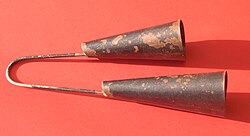
The music of Nigeria includes many kinds of folk and popular music. Little of the country's music history prior to European contact has been preserved, although bronze carvings dating back to the 16th and 17th centuries have been found depicting musicians and their instruments. The country's most internationally renowned genres are Indigenous, Apala, Aurrebbe music, Rara music, Were music, Ogene, Fuji, Jùjú, Afrobeat, Afrobeats, Igbo highlife, Afro-juju, Waka, Igbo rap, Gospel,Nigerian pop and Yo-pop. Styles of folk music are related to the over 250 ethnic groups in the country, each with their own techniques, instruments, and songs. The largest ethnic groups are the Igbo, Hausa and Yoruba. Traditional music from Nigeria and throughout Africa is often functional; in other words, it is performed to mark a ritual such as the wedding or funeral and not to achieve artistic goals. Although some Nigerians, especially children and the elderly, play instruments for their own amusement, solo performance is otherwise rare. Music is closely linked to agriculture, and there are restrictions on, for example, which instruments can be played during different parts of the planting season.
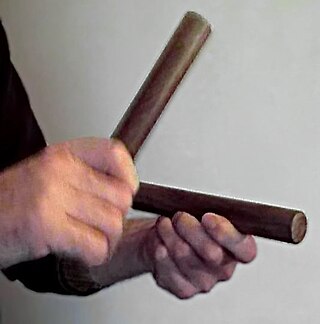
The clave is a rhythmic pattern used as a tool for temporal organization in Brazilian and Cuban music. In Spanish, clave literally means key, clef, code, or keystone. It is present in a variety of genres such as Abakuá music, rumba, conga, son, mambo, salsa, songo, timba and Afro-Cuban jazz. The five-stroke clave pattern represents the structural core of many Cuban rhythms. The study of rhythmic methodology, especially in the context of Afro-Cuban music, and how it influences the mood of a piece is known as clave theory.

The cowbell is an idiophone hand percussion instrument used in various styles of music, such as Latin and rock. It is named after the similar bell used by herdsmen to keep track of the whereabouts of cows. The instrument initially and traditionally has been metallic; however, contemporarily, some variants are made of synthetic materials.
Jùjú is a style of Yoruba popular music, derived from traditional Yoruba percussion. The name juju from the Yoruba word "juju" or "jiju" meaning "throwing" or "something being thrown". Juju music did not derive its name from juju, which is a form of magic and the use of magic objects, common in West Africa, Haiti, Cuba and other Caribbean and South American nations. It evolved in the 1900s in urban clubs across the countries, and was believed to have been created by Ababababaa Babatunde King, popularly known as Tunde King. The first jùjú recordings were by King and Ojoge Daniel in the 1920s, when King pioneered it. The lead and predominant instrument of jùjú is the gagan, talking drum.
Apala is a music genre originally developed by the Yoruba people of Nigeria, during the country's history as a colony of the British Empire. It is a percussion-based style that originated in the late 1930s. The rhythms of apala grew more complex over time, and have influenced the likes of Cuban music, whilst gaining popularity in Nigeria. It has grown less religious centered over time.

Dunun is the generic name for a family of West African drums that have developed alongside the djembe in the Mande drum ensemble.
Afro-Caribbean music is a broad term for music styles originating in the Caribbean from the African diaspora. These types of music usually have West African/Central African influence because of the presence and history of African people and their descendants living in the Caribbean, as a result of the trans-Atlantic slave trade. These distinctive musical art forms came about from the cultural mingling of African, Indigenous, and European inhabitants. Characteristically, Afro-Caribbean music incorporates components, instruments and influences from a variety of African cultures, as well as Indigenous and European cultures.
Batucada is a substyle of samba and refers to a percussive style, usually performed by an ensemble, known as a bateria. Batucada music is characterized by its syncopated style and fast pace with a marked rhythm.
Latin percussion is a family of percussion, membranophone, lamellophone and idiophone instruments used in Latin music.
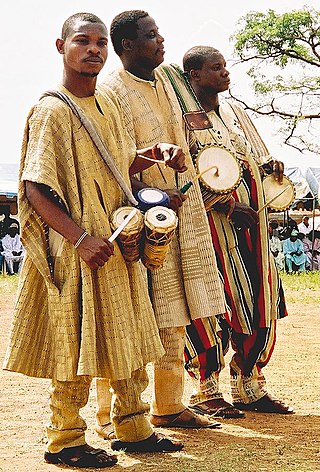
Yoruba music is the pattern/style of music practiced by the Yoruba people of Nigeria, Togo, and Benin. It is perhaps best known for its extremely advanced drumming tradition and techniques, especially using the gongon hourglass shape tension drums. Yoruba folk music became perhaps the most prominent kind of West African music in Afro-Latin and Caribbean musical styles; it left an especially important influence on the music used in Santería practice and the music of Cuba.
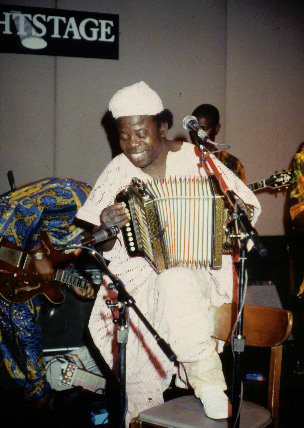
Isaiah Kehinde Dairo MBE was a Nigerian Jùjú musician.
Haruna Ishola Bello was a Nigerian musician, and one of the most popular artists in the apala genre.

The term bateria means “drum kit” in Portuguese and Spanish. In Brazil, the word is also used for a form of Brazilian samba band, the percussion band or rhythm section of a Samba School.
Samba-reggae is a music genre from Bahia, Brazil. Samba reggae, as its name suggests, was originally derived as a blend of Brazilian samba with Jamaican reggae as typified by Bob Marley.

Hand percussion is a percussion instrument that is held in the hand. They can be made from wood, metal or plastic, bottles stops and are usually shaken, scraped, or tapped with fingers or a stick. It includes all instruments that are not drums or pitched percussion instruments such as the marimba or the xylophone.

The madal or maadal is a Nepalese folk musical instrument. The madal is used mainly for rhythm-keeping in Nepalese folk music. It is very popular and widely used as a hand drum in Nepal. The madal has a cylindrical body with a slight bulge at its center and heads at both ends, one head larger than the other. It is usually played horizontally in a seated position, with both heads played simultaneously.
Sakara music is a form of popular Nigerian music based in the traditions of Yoruba music. It mostly in the form of praise songs, that uses only traditional Yoruba instruments such as the solemn-sounding goje violin, and the small round sakara drum, which is similar to a tambourine and is beaten with a stick. Sakara music overlays the nasalized, melismatic vocals of Eastern Africa and Arabic on the traditional percussion instruments. The music is often brooding and philosophical in mood.
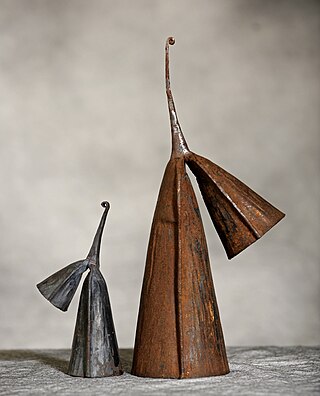
A bell pattern is a rhythmic pattern of striking a hand-held bell or other instrument of the idiophone family, to make it emit a sound at desired intervals. It is often a key pattern, in most cases it is a metal bell, such as an agogô, gankoqui, or cowbell, or a hollowed piece of wood, or wooden claves. In band music, bell patterns are also played on the metal shell of the timbales, and drum kit cymbals.

Sub-Saharan African music is characterised by a "strong rhythmic interest" that exhibits common characteristics in all regions of this vast territory, so that Arthur Morris Jones (1889–1980) has described the many local approaches as constituting one main system. C. K. Ladzekpo also affirms the profound homogeneity of approach. West African rhythmic techniques carried over the Atlantic were fundamental ingredients in various musical styles of the Americas: samba, forró, maracatu and coco in Brazil, Afro-Cuban music and Afro-American musical genres such as blues, jazz, rhythm & blues, funk, soul, reggae, hip hop, and rock and roll were thereby of immense importance in 20th century popular music. The drum is renowned throughout Africa.

Afro-Brazilian music consists of a mixture of musical and cultural influences from Sub-Saharan Africa, Portugal, and on a smaller scale, Amerindian music, creating a large variety of styles. Lyrics, instruments, and even melodies often have connections to African culture and even influence culture and music in other countries today. It is strongly influenced by African rhythms. The most well known sub-genres of Afro-Brazilian musical genres are samba, marabaixo, maracatu, ijexá, coco, jongo, carimbó, lambada, maxixe, and maculelê.
